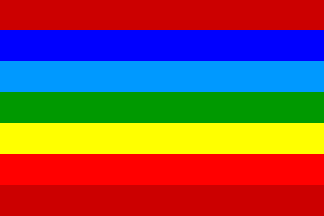 image by António Martins-Tuválkin, 15 March 2007
image by António Martins-Tuválkin, 15 March 2007
Last modified: 2025-10-04 by daniel rentería
Keywords: ecuador | qwishwa | inca | conaie |
Links: FOTW homepage |
search |
disclaimer and copyright |
write us |
mirrors
See also:
Beside of the fact that there are some basic versions of the
whipala, the flag is used together with the same flag but which
have squares in the rainbow colors instead of stripes (Kollasuyo)
the whipala with stripes is called the "tawantinsuyo"
flag, or the Inca flag, the Inca nation flag, the Quechua nation
flag. In Ecuador they have also some variants. The original flag
is the striped whipala, which was the coat of armor of the Inca,
long before they started to think of having a own gay flag,
rainbow warrior or other rainbow using flags in this world.
Concerning the flags which are used in the original Whipala, as
the images at this page EMBLEMA NACIONAL del PUSIN-SUYU =
TAWANTINSUYU- Huipala/wiphala, where and when did the rainbow
flag originate from?
The Indigenous banner is called "huipala" with the
seven colors of the rainbow (symbolizing the unity of indigenous
peoples before the conquest) and the black flags of
Ruminahui (legendary leader of the autonomous movement) and
Atahualpa La bandera indígena se llama: "huipala"
con los siete colores del arco iris (que simboliza la unidad de
la gente indígena antes de la conquista) y de los banderas
negros de Ruminahui (arranque de cinta legendario del
movimiento autónomo) y Atahualpa The Rainbow flag (Wipahla)
belong to the Native Andean people of Tahuantinsuyu for more than
500 years. Each color and its place in the flag as the rainbow,
have an own indigenous significance.
We have heard that the Indigenous org. of Cuzco , Peru is
thinking about finding another flag to symbolize our native
people, because of the problem above of using the flag by the
gays community and the International Co-operative Alliance,
claiming that they almost invented the flag in the 1920'ies.
Laila Holtet (www.nativeweb.org,webmaster of
CONAIE, Ecuador conaie.org),
9 July 2001
 image by António Martins-Tuválkin, 15 March 2007
image by António Martins-Tuválkin, 15 March 2007
The Cofanes are a native people from Ecuador. Its flag is
reported by Corbic (Vexillologie infos recherches [vir], issue 60) and it is Multistriped
R+, B, B-, V, Y, R, R+.
Source "Frontieres" at French TV channel Antenne2, 13
April 1994.
Jaume Ollé, 24 February 2007
The Cofanes (sometimes written Kofanes) are native people
living in the north of Ecuador (province of Sucumbios)
and neighbouring Colombia. They speak A'ingae, a language related
to the Western Tucano and Chibcha groups, and call themselves A'i
(lit., the people). In Ecuador, there are about 800 Cofanes
living in the communities of Duvino (7,032 ha), Sinangüé (7,000
ha), Dureno (9,571 ha), Zábalo (44,000 ha) and Chandia N'aen
(42,000 ha). In Colombia, the Cofanes live near the rivers
Guamés and San Miguel, in the reservations of Santa Rosa del
Guamés, Santa Rosa de Sucumbíos, Yarinal and el Afilador.
In 1602, Father Rafael Ferrer established good relations with the
Cofanes, setting up a first community called San Pedro de los
Cofanes. Ferrer wrote a catechism in Cofán language,
unfortunately lost. Ferrer described the Cofanes as obedient,
courageous and robust. However, the relations ended with the
murder of Ferrer in 1611. The Cofanes then opposed to any attempt
of conquest. In 1635, evangelization of the Cofanes was assigned
to the Franciscan, to no avail.
The first serious threat caused by colonization to the Cofanes
date back to the infamous period of rubber tree exploitation in
the Amazonian regions. In the beginning of the XXth century, the
Cofanes were called Cushma because of the tunic
("cuzma") that was their usual dress. After 1945, the
Cofanes established more contact with the outer word, represented
by the Instituto Lingüístico de Verano (ILV) and the oil
industry. The Bormans, from ILV, lived for more than 30 years
with the Cofanes; they set up the Cofán alphabet and written
language. Following an agreement between the government of
Ecuador and ILV, a program of bilingual education and
evangelization started in the 1960s. At the same time,
colonization by soldiers, traders, missionaries and all kind of
colonists progressed by the way of roads, trails and runways. In
1968, the Texaco company settled the Lago Agrio area, a
traditional territory of the Cofanes, and oil
exploitation started in 1972. The Cofanes natural and social
environment was destroyed and the Cofanes had to withdraw into
remote, small patches of land, where they still live today. The
missionaries have also significantly contributed to the
destruction of the social structure of the Cofanes, for instance
by suppressing traditional shamanic rituals like the yagé
ceremony.
Source: www.edufuturo.com, Edufuturo, Pichincha.
Ivan Sache, 4 March 2007
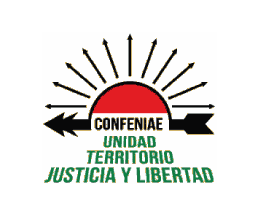
.gif) image created using logo, 27 September 2025
image created using logo, 27 September 2025
flag photo from opiac.org.co
logo from confeniae.net
The "Confederación de Nacionalidades Indígenas de la Amazonía Ecuatoriana", CONFENIAE (Confederation of Indigenous Nationalities of the Ecuadorian Amazon)
was established on August 24, 1980 in Puyo, Pastaza Province ( https://www.crwflags.com/fotw/flags/ec-y.html ). It is a regional indigenous organization that represents about 1,500 communities,
belonging to the Amazonian nationalities: Kichwa, Shuar, Achuar, Waorani, Sapara, Andwa, Shiwiar, Cofan, Siona, Siekopai and Kijus. It is currently located in Macas,
Morona-Santiago Province.
Main source: [1].
The flag is a white square background with the logo in the middle.
The logo depicts a rising sun with an arrow crossing through it, reading
CONFENIAE. Eleven sun rays are depicted for the tribes it represents. Underneath, the motto "UNIDAD TERRITORIO JUSTICIA Y LIBERTAD" (Unity, Territory, Justice and Liberty) is read.
Esteban Rivera, 12 September 2025
.gif) located by Jean-Marc Merklin, 12 September 2025
located by Jean-Marc Merklin, 12 September 2025
This variant, less commonly used, reads the name of each tribe it represents.
.gif) located by Jean-Marc Merklin, 12 September 2025
located by Jean-Marc Merklin, 12 September 2025
Instead of TERRITORIO, the logo read TIERRA.
Today I saw in TV some Ecuadorian indigenous flags. I saw four flags clearly and another one quite well:
Ecuadorian Quichua Flag
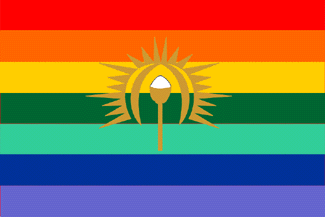 image by Jaume Ollé, 15 January 2000
image by Jaume Ollé, 15 January 2000
The first one seems to be the Ecuadorian Quichua flag. It is similar to the flag quoted by NAVA as "Inca" flags but with a sun in center. As is well known "Inca" is not a people but the name of the leader (emperor) of Quichua. According to NAVA there are 8 stripes but in the TV images there were only 7 (the white stripe is missing). Ratio c. 2:3
Ecuadorian Indigenous Flag
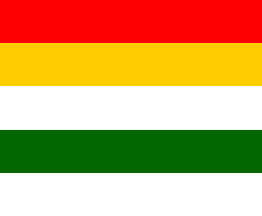 image by António Martins-Tuválkin, 17 October 2017
image by António Martins-Tuválkin, 17 October 2017
The second flag seems to be the Ecuadorian indigenous flag: is
five-striped red, yellow, white, green, white. Ratio c. 5:6 o 4:5
Jaume Ollé, 15 January 2000
Standard of the CONAIE
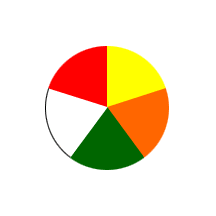 image by António Martins-Tuválkin,
14 July 2017
image by António Martins-Tuválkin,
14 July 2017
The third flag seems to be the standard of the CONAIE
(Confederacion de nacionalidades indigenas de Ecuador). It is a
square, white, with a circular logo or seal in center. The seal
is a circle of five colors: red, yellow, green, orange and white.
Jaume Ollé, 15 January 2000
The emblem is a disc divided in five equal sectors in the mentioned colors,
with one of the dividing radiuses being vertical on the flag, going from yellow
(pointing to the upper fly) through orange, green, and white, to red (pointing
to the upper hoist). Where the white sector meets the white background, there’s
a thin black dividing line, absent elsewhere.
António Martins-Tuválkin,
14 July 2017
Unknown Indigenous Flag
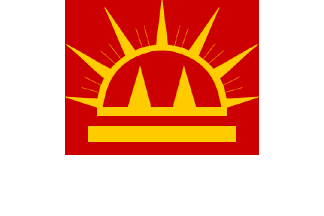 image by
António Martins-Tuválkin, 17 August 2017
image by
António Martins-Tuválkin, 17 August 2017
The fourth is unknown .It is a scarlet flag , bordered white in hoist, fly and lower part. In the scarlet part is a golden emblem (details of emblem approximate) . In the lower white part some words are written but unfortunately I couldn't read them from the TV image.
Indigenous Parliament Flag
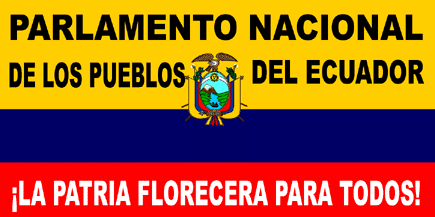 image by Jaume Ollé, 15 January 2000
image by Jaume Ollé, 15 January 2000
The last flag was the flag of the Indigenous Parliament. It is
the Ecuadorian flag but with inscriptions: "Parlamento
nacional - de los pueblos del Ecuador" (National Parliament
of the Ecuador peoples) in black on the yellow stripe, and
"¡La patria florecera para todos!" in white on the red stripe. ("Fatherland will flourish for all!). In
Spanish
"florecera" must be write with accent in the last
"A" but in the image the accent is missing, however
since the words are in capital letters it is possible to suppress
the accent.
Jaume Ollé, 15 January 2000
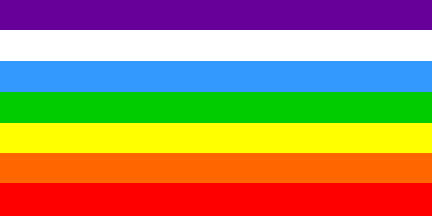 image by Ivan Sache, 31 May 2001
image by Ivan Sache, 31 May 2001
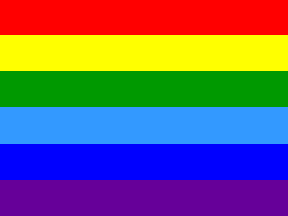 image by Ivan Sache, 31 May 2001
image by Ivan Sache, 31 May 2001
In today Israeli newspaper "Yediot Akharonot" there
is a photo of a
demonstration of the Indigenous people Ecuador. Two flags can be
seen clearly. Each one has a different order of stripes. One is
looks like: purple-white-blue-green-yellow-orange-red. The second
looks like: red-yellow-green-light blue-purple.
Dov Gutterman, 23 January 2000
All the information above is dated from January 2000, and is
linked to the events, involving the active participation of
Indians, which caused the impeachment of president Jamil Mahuad.
According to 'Universalia 2000' (Encyclopaedia Universalis
Yearbook, published in 2001), the chronology of the events is as
following:
- On 6 January, the government declared a state of emergency
because of increase in popular protest. The Patriotic Front, a
coalition of several unions, called for the Christian-Democrat
president Jamil Mahuad, which had been elected in 1998, to
resign. The president's economical policy had been strongly
criticized for months and the country faced a severe crisis.
- On 9 January, the president announced US dollar would replace
the Ecuadorian sucre as national currency, in order to stabilize
the monetary depreciation. This announcement caused a
radicalization of the protest.
- On 11 January, the representatives of the Indian nations, which
constitute about 30% of the country population, created a
'Parliament of Ecuadorian Peoples' (Parlamento Nacional de los
Pueblos del Ecuador). They called for the president's resignation
and civil disobedience. [The Parliament flag is shown above]
- On 16 January, the spokesman of the Patriotic Front, Luis
Villacis, was arrested with two other leftist leaders, within the
context of the state of emergency.
- On 21 January, the Indians marched against the capital Quito
and besieged the Parliament. [The flags reported by Jaume were
probably filmed during the siege.] Under the Indian pressure,
president Mahuad left the presidential palace and a triumvirate
was set up to replace him, constituted of General Carlos Mendoza
(Minister of Defence and Chief of the Army Staff), Antonio Vargas
(president of the Confederation of Indigenous Nations of Ecuador
[CONAIE, whose flag is shown above), and Carlos Solorzano
(past-president of the Supreme Court). General Mendoza quickly
resigned and the triumvirate was dissolved.
- On 22 January, vice-president Gustavo Noboa announced he would
take over the power. The Parliament, called in Guyaquil,
impeached Mahuad. The Indians, understanding they had been conned
once again, left peacefully Quito. The new president announced he
would maintain the 'dollarization' of the economy.
- On 26 January, Gustavo Noboa was invested by Congress.
'Universalia 2000' shows a colour picture which might be the same
as the one reported by Dov. As stated by Dov, there are two
horizontally divided flags to be seen in the picture background:
- purple-white-blue-green-yellow-orange-red with apparent
proportion 1:2.
- red-yellow-green-light blue-blue-purple with apparent
proportion 3:4. Dov did report only one blue stripe, but there
are
clearly two of them on my source. Proportions are surely without
any signification because these flags were probably home-made.
It would be interesting to know if the different variations on
the same pattern (colour horizontal stripes) refer to different
nations or are simply variations on a basic pattern used by all
indigenous nations (for instance, the first flag shown above is
attributed to Quechuas [note that my dictionary uses both
Quechuas and Kechuas, but not Qwishwas]).
Ivan Sache, 31 May 2001
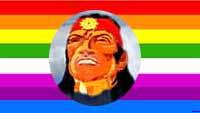 image from www.nativeweb.org
image from www.nativeweb.org
"Alianza Indigena" flag as appear at www.nativeweb.org/tawantinsuyu.
At the same page you can see another Indigenous Flag.
Dov Gutterman, 2 June 2001
Alianza Indigena (Indigenous alliance) flag is the rainbow flag with a disc
in the center containing a portrait of the Inca Rominahui as can be seen at www.nativeweb.org.
Interesting that the flag flown by the indigenous person in the
photo is a version close to that used by the gay community (6
stripes - Red, yellow, light green, olive green, blue, purple),
while the image in the page shows the flag of the gays (6 stripes
- red, orange, yellow, green, blue, purple) and the different
flag of the IA (8 stripes - red, orange, yellow, green, white,
lilac, dark purple, blue).
Jaume Ollé, 3 June 2001
I am the person who designed the Ruminahui flag at my pages. Both
the American COOP and the gay community have using the Inca flag ,
the rainbow and the serpent shied and Cuzco Inca flag of stripes
was "invented"! long before the Europeans came to
America. The gay community have not answered any email about this
presented by the United Indigenous Tribal Representatives, nor
from CONAIE, The indigenous leaders of Cuzco or anyone else. The
old leaders in Cuzco have been thinking about changing the design
of their NATIONAL flag because of this.
Laila Holtet (www.nativeweb.org,webmaster of
CONAIE, Ecuador conaie.org),
9 July 2001
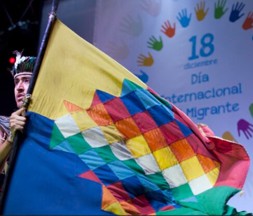 image located by Esteban Rivera, 11 July 2023
image located by Esteban Rivera, 11 July 2023
This flag was spotted on December 18, 2013 at the "Serenata al Migrante"
(English: Serenade to the Migrant) during the event "Día Internacional del
Migrante" (English: International Migrants Day ) (source:
https://twitter.com/cancilleriaec/status/412977131988086784) by the
"Ministerio de Relaciones Exteriores y Movilidad Humana" (English: Ministry of
Foreign Affairs and Human Mobility) (official website:
https://www.cancilleria.gob.ec) in
Quito, Ecuador.
It is most likely a commemorative flag with distinctive
pattern.
Source:
https://www.flickr.com/photos/94631446@N03/12366678913
Esteban Rivera, 11 July 2023